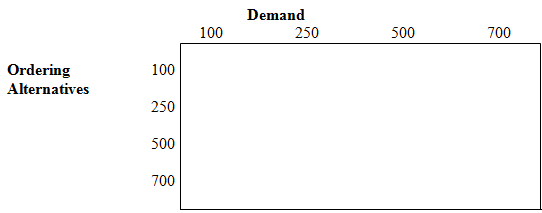Reference no: EM131567
Question 1. Edwards Life Sciences is trying to decide if it should sell a new type of medical product. Fixed costs associated to the production of the product are estimated to be $25,500. The product will sell for $1,200 with variable cost of $900. The sales manager believes that sales will be normally distributed with an average of 95 annually, with a standard deviation of 18.
a) What is the breakeven point?
b) What is the probability of a loss?
c) What is the profit/loss when 120 units are sold?
d) How many units must be sold to earn a profit of $15,000?
e) What is the probability of a profit of $15,000or more?
Question 2. A store sells Space Jam Magazine for $6 each, buys them for $3 each, and receives a $1 credit for every unsold copy that is returned to the distributor. Over the past 85 weeks it has experienced the following demand.
Demand 100 250 500 700
Number of Weeks 20 25 35 5
a) Fill in the payoff table below for the decision of determining how many magazines to order. Assume that the store cannot sell more magazines than it orders.
b) Determine the probability distribution for demand using the given data.
c) Using an expected profit criterion, which amount is the best amount to order?

Question 3. A company is trying to decide on an alternative to grow their production capacity. Payoffs (in thousands) have been estimated as follows.
Demand
Low Poor Good Excellent
A1 12 1 11 13
Alternatives A2 7 10 13 11
A3 15 14 -4 12
Probability .35 .30 .15 .20
a) Which alternative is best using a maximin criterion?
b) Which alternative is best using a maximean criterion?
c) Determine the expected payoff for each alternative. Which alternative maximizes expected payoff?
d) Determine the MAD for the A1 alternative. Do not find the standard deviation for the other alternatives.
Question 4. A company is trying to determine how to obtain more production capacity. They are considering the five alternatives given below. The results of the expected payoff and various risk calculations for each alternative are listed below.
a) Find the best alternative that has a maximum expected payoff and a MAD at most 200.
b) Find the best alternative that has an expected payoff of at least 290 and a standard deviation as small as possible.
c) Find the best alternative using MAD passed payoff at risk with alpha a = .10.
Demand:
High Moderate Low
Build Small 400 200 100
Build Medium 500 250 -150
Build Large 750 375 -400
Expand 350 300 100
Lease 300 300 200
Buy a competitor 500 300 100
Probability: .5 .3 .2
Expected Standard Mean Absolute
Alternative Payoff Deviation Deviation
Build Small 280 125 120
BuildMedium 295 247 205
Build Large 408 435 343
Expand 285 95 74
Lease 280 40 32
Buy a competitor 360 155 140
Question 5. A construction company is being sued as the result of an accident suffered by an employee. The plaintiff was working on a balcony railing when it gave way and he suffered serious injuries as a result. In his suit, he charged the company with negligence and asked for an award of $3 million. The company was advised by its lawyers that there is a 70% chance that the construction company will be found negligent. However, even with a negative verdict, there is only a 20% chance that the jury will award the full $2 million. There is a 50% chance that the award will be for only $1 million, a 20% chance it will be for $100,000, and a 10% chance the award will be $10,000. The lawyers also indicated that they could settle before the trial using an arbitrator. The lawyers believe that with an arbitrator there is a 60% that the plaintiff will be awarded $1,000,000, and a 40% chance that the plaintiff will be awarded $500,000. If they go to trial and are found negligent, they could settle for $1.75 million before the jury determines the award. There is also a third possibility of settling without a trial and without an arbitrator. In this alternative the cost to the construction company would be $900,000.
a) Construct a decision tree that represents this situation.
b) Determine what course of action the construction should take in order to minimize its expected cost.
c) Identify the worst case for the course of action given in part b)
Question 6. The S & P 500 and another stock, which we call stock XYZ, have the monthly percentage changes during 2011 given below.
a) Use the formula  = to determine beta.
= to determine beta.
b) On October 9, 2012 the stockAmazon (AMZN) has a beta of .82, and the stock Questcor (QCOR) has a beta of 1.58. If the expected payoff for both of these stocks is the same, which stock is a better investment based on the risk measure beta?
c) If a stock has a b much greater than 1, what does this mean?
|
Month
|
S & P
|
Stock XYZ
|
|
|
|
January
|
-0.0194
|
-0.1453
|
|
|
|
February
|
0.0635
|
0.0234
|
|
|
|
March
|
-0.0569
|
-0.1115
|
|
|
|
April
|
-0.028
|
-0.0508
|
|
|
|
May
|
0.0905
|
-0.1774
|
|
|
|
June
|
-0.0976
|
-0.1055
|
|
|
|
July
|
-0.0959
|
-0.1793
|
|
|
|
August
|
-0.0937
|
-0.1281
|
|
|
|
September
|
-0.0221
|
0.0027
|
|
|
|
October
|
0.0797
|
-0.0022
|
|
|
|
November
|
0.0757
|
0.0811
|
|
|
|
December
|
0.0382
|
0.1485
|
|
|
|
Sum
|
-.0660
|
-.6444
|
|
|